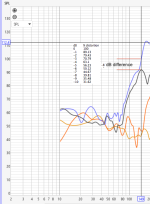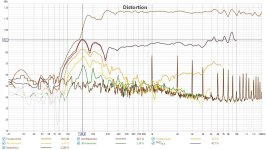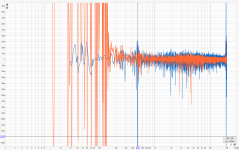Your data are imo only acceptable >300hzThe chart actually says 5% at 150hz.... is it wrong?
@weltersys comment was in regards to the 119db measurement inside of a living room. You need quietness to take thd, not a vibrating living room full of stuff. The last measurement is outside
You also have strange peaks in your noise floor.
I suggest using RTA with stepped sin for distortion analysis
The chart cross hairs show 112dB at 149Hz, but SPL is only 100dB, and THD at 92dB ~-8dB difference, near 40% THD, so something is wrong with the presentation. Lots of ways to view data in REW 😉The chart actually says 5% at 150hz.... is it wrong?
@weltersys comment was in regards to the 119db measurement inside of a living room. You need quietness to take thd, not a vibrating living room full of stuff. The last measurement is outside
Using your same data set at 140Hz, 92.2dB, THD is 74.4%, a few dB down from the fundamental:
I won't argue that you can or can't hear that distortion- hard to hear 92dB harmonics when the rest of the range is 119dB.
This is your thread, in the context of "low distortion", what do you consider low, 10%, 18%, 75%?
There is no wrong answer, just wondering what you think 😎
Art
Attachments
THD on the Axi2050/horn drops from 74.4 %@140Hz to under 46% at 149 Hz at 99dB.This is based on your data with spl set left upper corner:
By 300 Hz, THD is down to single digits- too bad the slot load dual 18" woofers drop like a rock around 160Hz.
Sorry to repeat prior posts, but Camplo brought the "low distortion" outdoor test back up yesterday..
I just figured out for one, I had the "plot at harmonic setting on".... but my numbers are still the same on thd.
edit: I found it, "use harmonic as ref" was checked
How do I make my chart read the same way>?
edit: I found it, "use harmonic as ref" was checked
What is being missed here is that it is the in-situ response that matters NOT some hypothetical free field response
The context for me, is related to dispersion. I've been looking at some in room measurements of the Abbey and comparing to my own in room measurements. Very crude way to compare but with certain things know, some ideas can be drawn. My room is worse than the comparison measurement room and my measurements are at a farther distance. Certain aspects might be expected to be in favor of one loudspeaker versus the other, and interesting is the contrast I see... The Abbey (greenish) measurement is at 55cm and the Cynosure (pink) is at 91cm, there is some degree of room treatment where the Abbey is measured and there is non in the room for the Cynosure measurements. GD is tighter for the large horn, when normally the farther away you move from a source the worse GD looks. Take with a grain of salt, a very crude comparison.

Attachments
These are the THD measurements I hope to discuss @weltersys
3v, 36", outside with Horn, No filter

3v , 9", inside with no Horn, No filter

Clipping on mic, occurs eventually at ~100db, and the THD is no longer accurate, but focusing on XO area, 200hz and below should be usable.
Whats loud? 110db/1meter should work, I think, if I am saying that 95db average is my max, then 110db is enough headroom.
Below are, no horn, measurements, at voltages, that I believe will result in 105db/211hz at 1m with horn. This is the worst area in the crossband, thd is lower, with higher & lower frequency, in the crossband. In stereo, that'd be 108db from the horns combined and 110db from the two mains, that is, horns and woofers combined. You asked what I thought low distortion was, I think staying within Xmax is a good isn't a bad place to be but I really don't know. Distortion increased by a factor of 1.407 without the horn, going from 3volts the higher voltage, judging by LZpeak or a factor 2.2 using ZFmax .. Will THD, using the horn, go from 4.97% to 10% in an 1m outdoor measurement? Maybe.... I understand that in concert with the crossing woofer THD will lower through the crossband. Am I squeezing by? Maybe. I'm not going to get below 2% thd at 110db but what If I get under 10%. Is that fail?


3v, 36", outside with Horn, No filter
3v , 9", inside with no Horn, No filter
Clipping on mic, occurs eventually at ~100db, and the THD is no longer accurate, but focusing on XO area, 200hz and below should be usable.
Whats loud? 110db/1meter should work, I think, if I am saying that 95db average is my max, then 110db is enough headroom.
Below are, no horn, measurements, at voltages, that I believe will result in 105db/211hz at 1m with horn. This is the worst area in the crossband, thd is lower, with higher & lower frequency, in the crossband. In stereo, that'd be 108db from the horns combined and 110db from the two mains, that is, horns and woofers combined. You asked what I thought low distortion was, I think staying within Xmax is a good isn't a bad place to be but I really don't know. Distortion increased by a factor of 1.407 without the horn, going from 3volts the higher voltage, judging by LZpeak or a factor 2.2 using ZFmax .. Will THD, using the horn, go from 4.97% to 10% in an 1m outdoor measurement? Maybe.... I understand that in concert with the crossing woofer THD will lower through the crossband. Am I squeezing by? Maybe. I'm not going to get below 2% thd at 110db but what If I get under 10%. Is that fail?
Here is an actual outdoor 1m measurement with 211hz playing higher 2db higher and THD is ~8.73%....Down to 179hz thd is 4.52% while playing higher than 110db fundamental target. Below you see the target imposed over the Raw 3volt 1m Horn outdoor response, everything below 179hz is over target spl. The last picture shows THD is 13% at 100hz in the 3v no horn 9" measurement. With the filter activated THD will fall... with the horn included THD will fall.... The no horn measurement shows a more intimate view and proves THD is not accurate at the lower levels of these outdoor measurements.
Below, the raw 1m horn+driver measurement shows 100% thd at 100hz but that cannot be true according to the no horn measurements taken at the same voltage. Once again, I think, I may have actually created enough headroom.
On the topic of Diffraction< these two bumps in the raw, no horn response

Are likely the same humps we see here... Suggesting that ideas of modulation due to "undersized mouth" or "lack of proper roll off", are fallacy in this case.

There is no large modulations or major diffraction, in the on axis of this horn, is what I would conclude.
Are likely the same humps we see here... Suggesting that ideas of modulation due to "undersized mouth" or "lack of proper roll off", are fallacy in this case.
There is no large modulations or major diffraction, in the on axis of this horn, is what I would conclude.
This is the wonderous part of the audio hobby. Things are the reverse WRT frequency space, namely the HF and LF sides of our situation are polar opposites. What is bad in one is the opposite of the other. For example, the referenced statement is totally valid, but only at LFs where the modes dominate things and our perception is slow, meaning that we hear almost steady state. But you see that the opposite is true of the HFs. The modal density is so high that we can ignore it, and we process things very quickly such that only the free field response is useful. These regions are direct opposites and any statement about one of them is going to be false in the other. Hence, without context one can always find them false somewhere.Where's the context to the above post? Reading the whole quoted post and the discussion around it, it wasn't specifically centred around harmonic distortion.. however as you'll see qualified in the quoted post, excursion/power are also necessary considerations.
And obviously there is a transition domain where things can be either/or/and. This all depends on the timing of the reflections. It can get quite complicated.
My surround, has started to come off of the frame. When the driver oscillates, it slaps the frame causing noise, a loud noise actually.... I was thinking to use epoxy resin to reattach it. I am not sure if thats the right solution, anyone have a suggestion. I just took this driver out of storage in so many words and ran test signals, it started as a tiny tick and then eventually after testing commenced, the the tiny tick turne into a loud tick. Looks like an easy fix, just wondering what type of adhesive is recommended. Even though this woofer has a low hours, the time from purchase till now is something like 2 years so I don't think any type of warranty applies.

Hi,
I have repaired similar damages with some thin cotton fabric and "Pattex" glue. I would stay away from epoxy on moving parts like this.
//Anders
I have repaired similar damages with some thin cotton fabric and "Pattex" glue. I would stay away from epoxy on moving parts like this.
//Anders
I dunno, I am leaning towards resin epoxy. That part of surround isn;t a moving part, its supposed to be fixed to the frame.
I would use epoxy, but with care not to get any one the surround itself.
This is a very poor build quality. I'd switch suppliers if I were you. That fault will just foreshadow others.
This is a very poor build quality. I'd switch suppliers if I were you. That fault will just foreshadow others.
I didn't want to say it, but you said it for me.... the sad part is that the malfunction happened will not being used. The woofer sat for near 6 months....I moved the sub downstairs and ran test tones, I thought I got something in the motor from moving it around. Turned out to be suspension/frame separation
Warranty would cover it if I went by received date.... website says they judge by purchase date.... well I purchased the woofers in 2019 but received them in 2020 4+ months later.
I don't think there is a woofer with similar specs to the AE 18h+...
According to those who go "Brrrrrrp" (slang from basshead culture) E6000 is the solution.
Warranty would cover it if I went by received date.... website says they judge by purchase date.... well I purchased the woofers in 2019 but received them in 2020 4+ months later.
I don't think there is a woofer with similar specs to the AE 18h+...
According to those who go "Brrrrrrp" (slang from basshead culture) E6000 is the solution.
Last edited:
- Home
- Loudspeakers
- Multi-Way
- Is it possible to cover the whole spectrum, high SPL, low distortion with a 2-way?


